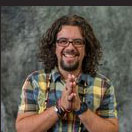
Idea-feelings - Like tiny moss on stones. Oh yes oh yes!
In a poem entitled The World’s Feeling,[1] the Brazilian poet Carlos Drummond de Andrade has a line that says: “I have only two hands and all the feelings of the world.” I love this metaphor and I feel that this is how I have been living lately. The political arena seems to be depleting us day by day with news of atrocities, shocking moves that place the world at a tipsy point, and new national laws that put people in danger and potential situations of disaster. And we have just started! Too many feelings, too much disastrous news, and too few defused responses and ideas without anything that seems to be truly articulating the moment in any clarifying direction. Every movement is divided. The so-called leftists, living in a time of potentialities to create a new left, is bitterly divided over issues either defending one candidate or accusing another. However, there have been positive moments. The Women’s March was a balm to many of us. As were the responses from Boston and NYC about Trump’s threat to immigrants and registering Muslims.
As a citizen and as a teacher, I feel the weight of the feelings of the world and yet I only have two hands to deal with it all. The task of living our days in resistance to power seems insurmountable and that also seems to be the hope of the leaders of this country. The battle at hand is not only on the front of new laws and administrative resolutions but also on the controlling of feelings and emotions. The attack on media as the new enemy, the creation of “alternative facts,” and actions such as “President Donald Trump to publish a weekly list of crimes committed by immigrants,”[2] are all tactics used by the government to disturb our feelings and confuse our ideas. This is not removed from the classroom. Students carry their emotions into every class.
Teaching engages the world of ideas and contemporary movements. Teachers must engage ideas and human feelings at the same time. Ideas are dependent on feelings and feelings are affected by ideas and it is in this chiaroscuro time and place where teachers work. Antonio Gramsci defines our time in precise ways: “The old world is dying, and the new world struggles to be born; now is the time of monsters.” An empire is eroding, a collapsing new world order is emerging and in the midst of it all, there are monsters of all kinds! We can surely name them! It is in this chiaroscuro time that faculty are called, even demanded, to attend to teaching in ways that take seriously the complicated interplay between ideas and feelings in their subject matters and within the student’s lives.
Our classrooms are containers of the world’s feelings with only few hands. However, if education is for life and not for a program of profit and if outcomes are hoped for the decolonization of the minds and bodies and not to fulfill a neoliberal project of processual measurement, then we can meet each other now; but also, beyond the surroundings of the classroom: in soup kitchens, in marches for rights of people, in strikes against economic austerity deals of destitution. We can continue to organize something that will be plural, filled with ambiguities and paradoxes, but that can somewhat, produce sustainable forms of resistance to be engaged.
In order to do that, teachers must teach with their heart and mind filled with feelings of strength and possibilities. Classrooms must be places for thinking and feeling, where emotions embolden ideas and where ideas help organize emotions. Our classes should fuse Descartes with Antonio Damasio: we think and we feel, therefore we are! We need idea-feelings, that is, thinking that feels and feelings that think. In this way, classrooms will be spaces with deep liberating thinking and expansive feelings. The song Volver a Los 17[3] (Returning to seventeen) calls us to engage our feelings:
What feelings can grasp
knowledge cannot understand,
not even the clearest move
not even the widest thought,
the moment changes everything
We need poetry and songs to continue moving! Art, poetry, and songs to expand us, to help us be better teachers. The same song says something akin to our endless task of teaching:
Entangling, entangling it moves,
like the ivy on the wall,
and so it flowers, and it grows,
like tiny moss on the stone.
Oh yes oh yes
We are ivy on the wall of empire! Entangling in everything there is. We are flowers inside of guns, we are tiny mosses on the stones of our reality. Oh yes oh yes! When our minds cannot grasp the intensity of this moment, we can recur to our hearts. For there, in our hearts, if well cared, we can find solace, peace, and sustenance. For the hearts of teachers are bigger than anything. The hearts of teachers embrace all kinds of students and realities, wrestle with all kinds of theories, and engage all forms of thinking-feeling. So we don’t fear the world! If the world looks frightening, our heart knows better. As the same poet Drummond says…
World, world, wide world, wider is my heart.[4]
[1] Carlos Drummond de Andrade, Sentimento do Mundo.
[2] http://www.independent.co.uk/news/world/americas/donald-trump-publish-weekly-list-crimes-immigrants-commit-refugees-aliens-executive-order-us-a7546826.html?cmpid=facebook-post
[3] Song by Violeta Parra. Hear the song here by Mercedes Sosa and Milton Nascimento: https://www.youtube.com/watch?v=MB37oAxOkzA
[4] Carlos Drummond de Andrade, Poema de Sete Faces.
Leave a Reply